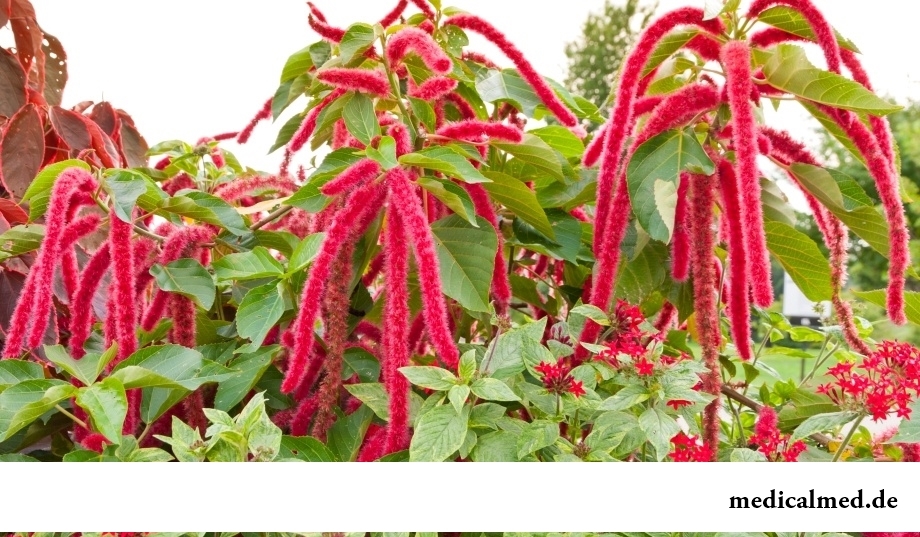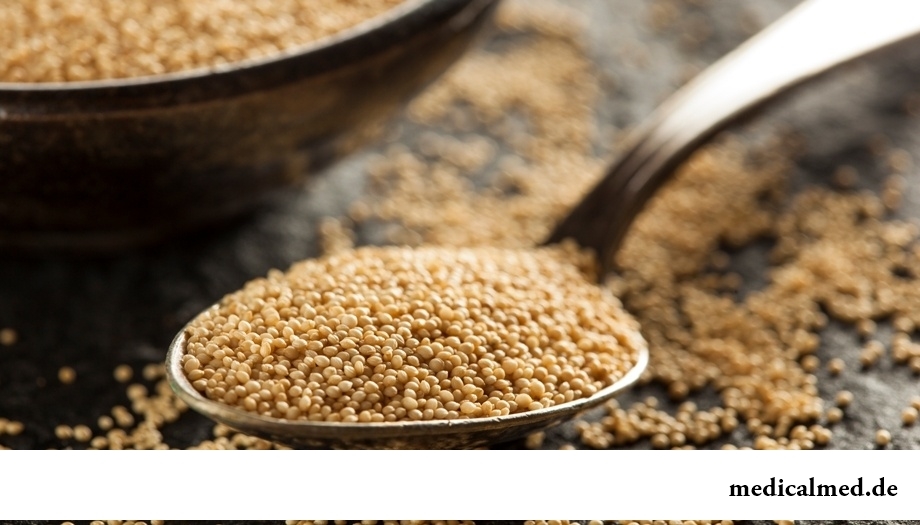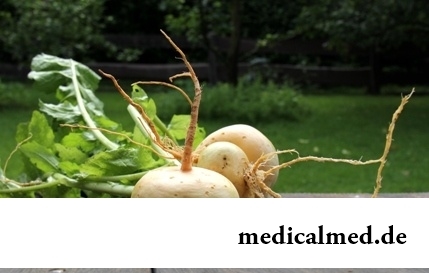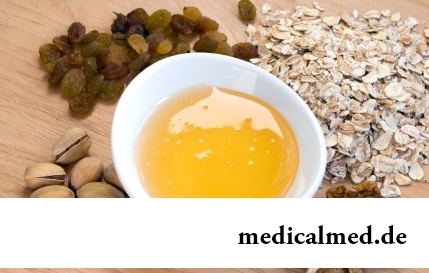





Amaranth
The amaranth is a herbaceous plant from family amarantovy which has small flowers and kolosovidny inflorescences. Now there are more than 60 species of this plant.

The amaranth received positive reviews as the useful and vitaminized plant.
Broad use has an amaranth in medicine, cosmetology and cookery.
Biological features and distribution
Some types of an amaranth are ancient grain crops which grew up in East Asia. In modern time in the Southern Asia the amaranth is used as vegetable. It has the hanging-down inflorescences and the painted leaves.
The amaranth in Europe has branchy stalks, rhomboid leaves with an acute top, and also flowers which form bunches with tops – whisks. Usually color of a plant green, and in certain cases - red.
For the first time the amaranth is grown up in South America, and then delivered to India, China and North America. Some species of a plant removed in the artificial way grow in the countries of East Asia.
To Europe the plant was delivered in the 18th century by Spaniards and was used as fodder culture, but then became only a weed on fields with cereals. In Russia this plant appeared from the middle of the 19th century and at first was considered as weeds, and then began to be used in the decorative purposes. Applied an amaranth to creation of a "live" fence and department of economic constructions, and also to flower compositions.
Now the amaranth is grown up as an annual plant which begins to be sowed in the form of seedling since the beginning of April, and land in soil in the middle of May.
Useful properties of an amaranth
The advantage of an amaranth, thanks to its valuable structure, vitamin-rich and active agents is high. Leaves of a plant contain useful substances which are effective for prevention of osteoporosis, elimination of deficit of calcium in an organism, regulations of exchange processes and decrease in probability of developing of cardiovascular diseases.
Useful properties of an amaranth influence activity of removal from an organism of harmful substances, including radionuclides. As a part of an amaranth phytalbumins which are effective at treatment of eczema, small tortoiseshell and dermahemia.
The amarantovy oil made of a plant contains a set of microelements and useful substances which are effective prophylactic against formation of malignant tumors.
The amaranth received positive reviews for the content of squalene which oxygenates an organism, is antineoplastic means and an immunostimulator. Squalene is necessary for a human body for reduction in the rate of oxidizing processes in cells which cause aging of an organism.
The international medical researches showed that constant consumption of an amaranth positively influences functioning of a liver, promotes regeneration and performs functions of kroveostanavlivayushchy cure for hemorrhoids and internal bleedings.
Broad use has an amaranth in the form of tincture which is used as an antispasmodic at colitis, gastritises and locks.
Useful properties of an amaranth are shown at treatment of infectious diseases, dermatitis, endometriosis and fungal infections.
At an allergy and diathesis broth of roots and seeds of an amaranth well helps, and at burns and scars plant oil is effective.

Use and consumption of an amaranth
The amaranth is used not only fresh, but also in the form of tincture, broth and oil. Tincture prepares on the water bath and is applied within 14 days (in 30 minutes prior to food) at enuresis and other inflammations of urinogenital system.
Collecting a camomile, amaranth and St. John's Wort promotes rejuvenation and recovery of an organism, and also cell regeneration. From roots of an amaranth prepare special broth which is accepted on 1/3 glasses by 2 times a day.
For the refreshing and antiinflammatory bathtubs use the crushed amaranth leaves which boil within 20 minutes and pour in a bathtub. Juice from leaves of a plant is applied to rinsing of an oral cavity, and also to treatment of gastritis, disturbances of functioning of a liver and a diabetes mellitus.
Leaves of this plant to taste are similar to spinach and from them tasty salads, soups and borsches turn out. Leaves in a dry form are used as a vitamin supplement, and seeds of an amaranth are similar to hazelnuts and add them to teas, and also use at conservation of vegetables.
Contraindications
Despite a set of positive reviews, an amaranth has also contraindications.
Contraindications to the use of an amaranth are the individual intolerance and existence of allergic reactions. It is not necessary to use a plant at a serious illness of the alimentary system, cholecystitis, an urolithiasis and disorders of intestines.
Children should not eat often an amaranth, and also it is better to give it together with other vegetables and olive oil to avoid negative impact on the alimentary system.
People who got used to have breakfast regularly have obesity much less often.

Statistically, at the address to doctors seven of each ten patients complain of a headache. Actually people, periodically...
Section: Articles about health
Climax - process of fading of reproductive function of an organism in process of its aging. At women the main sign of its approach is the termination of a menstrual cycle. Officially the menopause is diagnosed when periods are not observed in течен...
Section: Articles about health
Cold is such painful that each sigh becomes a victory, heat "knocks" down, and the ache in joints forces to think only of pain. Some people with approach of the first symptoms of cold make the self-sacrificing decision to have a disease standing, and at best to rest in bed with a cup of hot tea. There is an opinion that if not to treat cold, then the organism itself, sooner or later, will overcome an illness. Whether so it? It is known that if in time it is simple not to begin treatment, apparently, harmless...
Section: Articles about health
New year, wedding, birthday, office party – an occasion to drink at the Russian person will always be. How to reduce a negative impact...
Section: Articles about health
Hemorrhoids – extremely widespread disease. Periodically arising inflammations and bleeding of hemorrhoidal nodes cause serious discomfort to nearly fifteen percent of adults. Meanwhile, having a clear idea of the aggravation reasons...
Section: Articles about health
Many parents of children at the age of 2-4 years face excessively whimsical behavior of the child. The kid exhausts constant crying and whims not only the parents, but also himself. In what the reasons of children's whims. And how to fight with them?...
Section: Slideshow
The name of this disease precisely reflects the problem reason: it consists in the bra fastener pressure upon a certain zone...
Section: Articles about health
The stroke is one of the most widespread diseases of the person, annually in the world about 6 million cases of this pathology are registered. According to medical statistics, strokes occur almost three times more often than myocardial infarctions. Disease otno...
Section: Articles about health
Feeding by a breast - the integral part of ideal motherhood allowing to come into contact with the kid and to create to it healthy immunity since early years. Nevertheless, this important process in life of mother and child can be saddened laktostazy − by a milk delay in a mammary gland. What main reasons for a laktostaz? How not to allow problems with breastfeeding? Let's consider 10 premises resulting in stagnation of milk at the nursing mother....
Section: Articles about health
The nature does not stand stagnation and monotony. It is known that tissues of a human body atrophy if do not receive necessary loadings...
Section: Articles about health
Practice of use of table salt in the therapeutic purposes contains not one century. Applications which do by means of the fabric impregnated with saline solution are considered especially effective. They possess antibacterial and antiinflammatory эффек...
Section: Articles about health
Energy saving lamps are one of the most popular products of innovative technologies, and there is no wonder: they much more economic also are more long-lasting than usual filament lamps. At the same time there are fears that energy saving bulbs can become the reason of emergence of problems with health. Unfortunately, some of similar opinions have the real reasons....
Section: Articles about health
The healthy nutrition is the invariable principle of health and good health for long years of the woman. Nevertheless, in рацио...
Section: Articles about health
Scientists always aimed to offer fundamental explanations for medical problems. Their theories formed the basis of modern methods of treatment of the hardest pathologies and helped to save a set of lives. However stories are known also such theoretical constructions, following to...
Section: Articles about health
Turnip, radish, horse-radish – once these and other products enjoyed wide popularity at our ancestors, being not only the food sating an organism but also the medicines curing of many diseases. Unfortunately, the use of some of them got out of fashion long ago, and once favourite plants and vegetables almost ceased to make a contribution to human health. Inclusion of such products in a modern diet − an effective measure of prevention and treatment of diseases which seldom suffered...
Section: Articles about health
For the person who daily since morning gathers for work it is very important to wake up vigorous and ready by day of work. On most...
Section: Articles about health
Let's begin with the fact that a separate illness which is called "adjournment of salts", just does not exist. In practice this household name of disbolism leading to development of a number of diseases. Pathological process consists that in an organism проис...
Section: Articles about health
Sometimes it seems that modern society was divided into two camps: representatives of the first are sure that only the woman has to be responsible for contraception, representatives of the second, respectively, are sure that it is destiny of men. Meanwhile the question of contraception has very many aspects – both psychological, and legal and, of course, medical....
Section: Articles about health
Obesity is called by a disease of 21 centuries, for the last 100 years by the number of the people suffering from excess body weight, considerably increased...
Section: Articles about health
Dietary supplements (dietary supplements) for the last decades were so thoroughly included into our life that, apparently, it is already impossible to find the person who at least once did not try them. At the same time, most of our compatriots have a vague idea about...
Section: Articles about health
Water with a lemon - idle time in preparation drink which supporters of a healthy lifestyle already managed to appreciate. Used in a warm look and on an empty stomach, it is one of the most useful prophylactics allowing to prevent tens of diseases and just to raise an organism tone. Especially effectively to use warm water with lemon juice after a serious illness, during a season of the colds, and also to children, old men and pregnant women which do not have contraindications...
Section: Articles about health
Olive oil – the product capable to make a powerful contribution to health of the person if it includes it in the diet. Rich vitamin...
Section: Articles about health
Deciding to get rid of an addiction, not all imagine what effects it is necessary to face. Process of refusal of smoking causes quite essential discomfort in most of people: differences of mood, sleep disorder, fatigue, decrease физич...
Section: Articles about health
Any person who faced a disease knows that treatment costs expensive. It belongs also to consultations of qualified specialists, and to the diagnostic procedures which are not included in the list of obligatory medical services. The question of cost of medicines is not so unambiguous: almost each drug is produced several producers at once, and the price of medicine can differ many times. In such situation there is a sense to understand in what differ from each other original environments...
Section: Articles about health
History of use of an anesthesia during operations contains more than 160 years. Annually in the world hundreds of thousands surgical вм are carried out...
Section: Articles about health
The endocrine system carries out extremely important role in a human body, practically all processes of life activity are regulated by it. Closed glands (hemadens) produce special biologically active agents – hormones which then o...
Section: Articles about health
Nightmares belong to the most unpleasant frustration. Statistically, they happen at 4% of adults, and almost at 70% of children and teenagers. During a nightmare of people dreams himself in extremely difficult, life-threatening situation. He wakens suddenly, in a condition of a fright, and, as a rule, remembers the dream distinctly. The feeling of depression and alarm does not release throughout the day, creating hindrances for work and normal communication. If such episodes repeat often, can р...
Section: Articles about health
